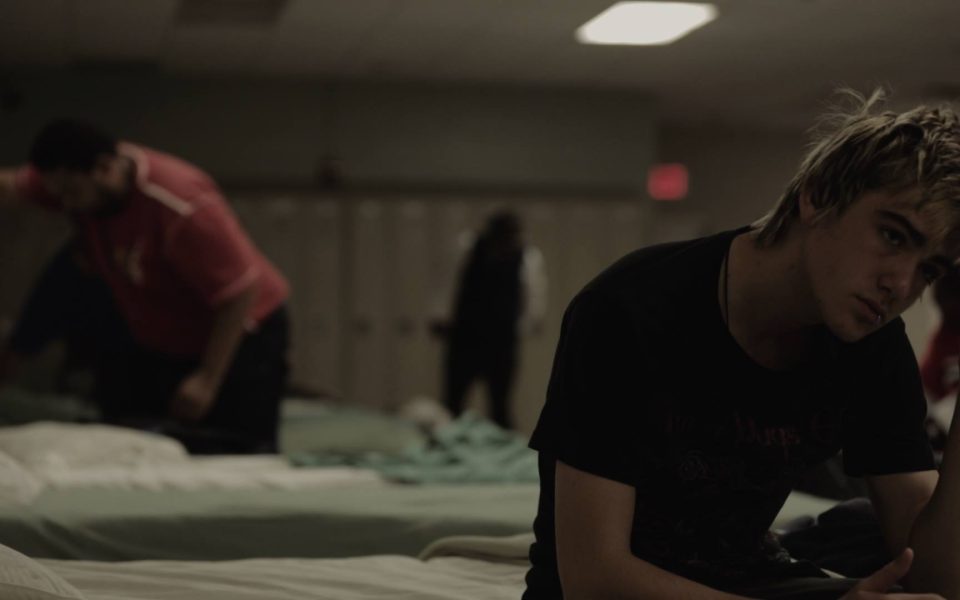From the seats in one of Aperture Cinema’s theaters, the air onscreen is visibly frigid on Winston-Salem’s Cherry St. where teenaged protagonist Gosh, pronounced “Josh,” tilts his gaze upward to behold a Moravian star, a luminous emblem of the city’s colonial heritage, hanging from a lamppost.
This is among the opening montage of Homeless, a narrative feature film based on a true story from husband-and-wife team Clay and Tif Hassler. The duo directed and produced the film in the Twin City over a combined 25 days back in 2012 on a tight, $12,000 budget. The couple, who now live in Nashville, made a point to feature only locals with little to no acting experience. The screenplay, co-written with Anna Fields, grew out of a happenstance encounter with Gosh, a young man portrayed by Michael McDowell, who’d fallen into destitution and homelessness after his grandmother passed away.
“What was so surprising to Clay and I was that this 18-year-old kid was homeless just because his grandmother passed away,” Tif Hassler says in a post-screening interview. “He didn’t have a support system at all; he was completely on his own.”
Speaking on a panel following the Sept. 13 screening, both filmmakers stressed the importance of working in the Samaritan Ministries shelter leading up to and following film production; they spent a week filming in the actual shelter with its staff and residents. Their aversion to sugarcoating or relying on stereotypes of people experiencing cyclical homelessness shows throughout the film.
“We loved being there,” Tif says. “We found real community and met a lot of people who it was one thing after another and all of a sudden they were homeless, no fault of their own. It was the circumstances around them and the lack of support either in the family they do or don’t have…. Every story is different.”
In the film, Gosh’s begins with a stint at Samaritan’s men’s shelter. Lance Megginson portrays an older man with a penchant for the piano at the shelter who approaches Gosh again and again in attempts to afford the teen with another form of shelter — friendship, and hopefully, mentorship. He acts as a pseudo-bodyguard so Gosh can finally take a shower un-harassed and, eventually, Gosh opens up about his plans to save up for an apartment with Megginson’s (unnamed) character.
“A lot of people say that,” he replies, “They’re always outside that door at 7[p.m.]”
Hassler juxtaposes Gosh’s perpetual state of dejection with a few spikes of joyfulness, though. He laughs, playing at Northside Bowling alongside a new friend, Krystal (Hosanna Gourley), and enjoys a tender moment on Christmas morning, but the levity never lasts. Even characters like Tina, who invites Gosh to sleep on her couch and helps him secure a gig holding signs for egg drop soup lunch specials at Hanes Mall, disappoint eventually. But there are no tall tales about good and evil in Homeless. The single mother barely able to provide groceries is treated as fully human even as she betrays the striving protagonist in her desperation to stay afloat financially and emotionally.[pullquote]Learn more at homelessthefilm.com.[/pullquote]
It’s laudable that Clay is careful not to sentimentalize Gosh’s relationships with Tina or the man at the shelter, and those tenuous relationships mirror the fragility of his situation. He finds, time and again, that pure perseverance is not always enough in the face of stigma, assumed moral failing and systemic roadblocks, not the least of which is a simple question on every formal job application: What’s your address?

©
So while it’s a feature film with three acts, Homeless might feel more like a documentary at times to those familiar with city scenes like Camino Bakery’s Fourth Street storefront or the colorfully-painted pillars at the bus depot between Liberty and Trade streets. No scene feels forced, but plenty mimic the isolation that accompanies homelessness: Long stretches pass without dialogue, only sullen piano chords to accompany ashen backdrops like Gosh’s visit to his father at Randolph County Correctional Center in Asheboro.
Gosh is on a steadier path now and, he reports during the evening’s panel, happy. He works a landscaping job in Greensboro, finds pride in holding down his apartment and sees his father, since released from incarceration, frequently. But this news comes the better part of a decade after the Hasslers decided to help Gosh tell his story.
“We alone did not help Gosh, it was a team of people, wrap-around services,” Tif says. “Samaritan did so much for him. It’s cliché but it took a village to really surround a kid like him who didn’t have anyone. An individual can make change, but it’s an individual within a community that can really make changes. In the community in on board, we could change the world.”
It’s fitting that Homeless leaves viewers unsettled, and a little exhausted, as they find Gosh with no more money than he carried at the outset and no place to call home. Despite it all, Gosh gazes skyward at the end of the film to the Moravian stars, those radiant symbols of hope lighting the way against the unforgiving chill.
Join the First Amendment Society, a membership that goes directly to funding TCB‘s newsroom.
We believe that reporting can save the world.
The TCB First Amendment Society recognizes the vital role of a free, unfettered press with a bundling of local experiences designed to build community, and unique engagements with our newsroom that will help you understand, and shape, local journalism’s critical role in uplifting the people in our cities.
All revenue goes directly into the newsroom as reporters’ salaries and freelance commissions.


Leave a Reply